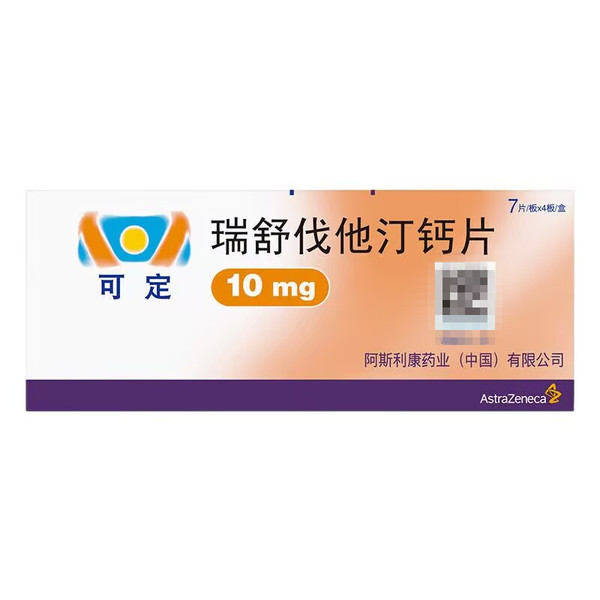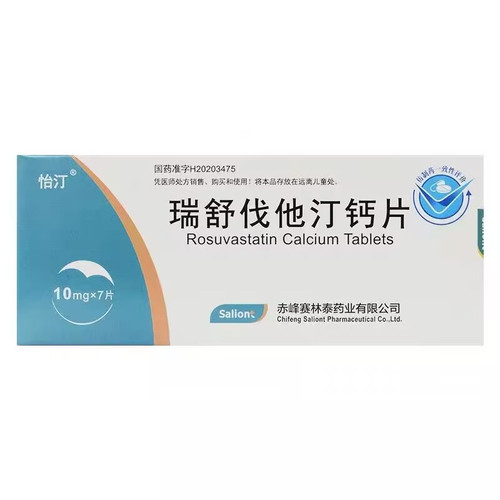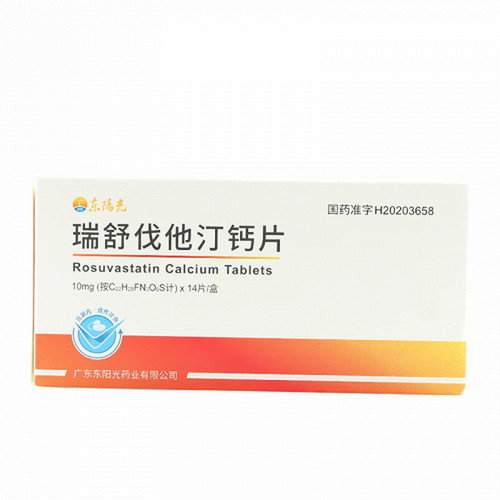Product Overview
[Drug Name]
Generic Name: H Rosuvastatin Calcium Tablets
Trade Name: Kodin H Rosuvastatin Calcium Tablets 10mg x 7 tablets
[Main Ingredients]
The active ingredient of this product is rosuvastatin calcium. Chemical Name: Bis-[(E)-7-[4-(4-fluorophenyl)-6-isopropyl-2-[methyl(methylsulfonyl)amino]-pyrimidin-5-yl](3R,5S)-3,5-dihydroxyhept-6-enoic acid] calcium salt
(2:1) Molecular Formula: (C22H27FN3O6S)2Ca Molecular Weight: 1001.14
[Properties]
Rosuvastatin Calcium Tablets 5mg are round, yellow, film-coated tablets, embossed with "ZD4522" and "5" on one side and smooth on the other side. Rosuvastatin calcium tablets 10mg are round, pink, film-coated tablets, embossed with "ZD4522" and "10" on one side and a smooth surface on the other side. Rosuvastatin calcium tablets 20mg are round, pink, film-coated tablets, embossed with "ZD4522" and "20" on one side and a smooth surface on the other side.
[Indications/Main Functions]
This product is indicated for the treatment of primary hypercholesterolemia (type a, including heterozygous familial hypercholesterolemia) or mixed dyslipidemia (type d), whose dyslipidemia is not adequately controlled with diet and other non-drug therapies (e.g., exercise therapy, weight loss). This product can delay the progression of atherosclerosis in adult patients while in conjunction with lipid-lowering therapy. This product is also indicated for patients with homozygous familial hypercholesterolemia as an adjunct to diet and other lipid-lowering measures (e.g., LDL-density lipoprotein cholesterol depletion), or when these measures are inadequate.
[Specifications]
10mg*7 tablets
[Dosage and Administration]
Before starting treatment, patients should follow a standard cholesterol-lowering diet and maintain this diet during treatment. The use of this product should be individualized, taking into account the patient's cholesterol level, anticipated cardiovascular risk, and potential for adverse reactions. Oral administration. The usual starting dose of this product is 5 mg once daily. The starting dose should be selected based on the patient's cholesterol level, anticipated cardiovascular risk, and potential for adverse reactions. For patients requiring more intensive low-density lipoprotein cholesterol (LDL-C) lowering, a 10 mg once daily starting dose can be considered; this dose controls lipid levels in most patients. If necessary, the dose can be adjusted to a higher dose level after 4 weeks of treatment. The maximum daily dose is 20 mg. This product can be taken at any time of day, with or without food. Patients with Renal Impairment: No dose adjustment is required for patients with mild to moderate renal impairment. All doses of this product are contraindicated in patients with severe renal impairment. Patients with Hepatic Impairment: Systemic exposure to rosuvastatin was not increased in subjects with a Child-Pugh score of 7 or less. Increased systemic exposure was observed in subjects with Child-Pugh scores of 8 and 9. In these patients, renal function should be evaluated. There is no experience with the use of this product in patients with a Child-Pugh score greater than 9. This product is contraindicated in patients with active liver disease. Increased systemic exposure has been observed in subjects of Asian descent. This factor should be considered when determining the dose for patients of Asian descent. Dosage recommendations for patients with predisposing factors for myopathy: The recommended starting dose for patients with predisposing factors for myopathy (see [Precautions]) is 5 mg.
[Adverse Reactions]
See the package insert for details.
[Contraindications]
This product is contraindicated in: · Patients with hypersensitivity to rosuvastatin or any of its components. · Patients with active liver disease, including unexplained persistent elevations in serum transaminases and any elevation in serum transaminases exceeding 3 times the upper limit of normal (ULN). Patients with severe renal impairment (creatinine clearance <30 mcg/min). Patients with myopathy. Patients taking cyclosporine concomitantly. Pregnant or breastfeeding women, as well as women who may become pregnant and are not using adequate contraceptive measures.
[Precautions: Renal Effects]
Proteinuria (as measured by dipstick) has been observed in patients treated with high doses, particularly 40 mg. The protein is primarily derived from the renal tubules and, in most cases, is transient or intermittent. Proteinuria is not considered a precursor to acute or progressive renal disease (see Adverse Reactions). Skeletal Muscle Effects: Skeletal muscle effects, such as myalgia, myopathy, and, rarely, rhabdomyolysis, have been reported in patients treated with all doses of ezetimibe, particularly in doses greater than 20 mg. Extremely rare cases of rhabdomyolysis have been reported with the concomitant use of ezetimibe and HMG-CoA reductase inhibitors. Drug interactions cannot be ruled out; caution should be exercised when these drugs are used together. Creatine kinase (CK) testing should not be performed after strenuous exercise or in the presence of plausible causes of CK elevation, as this can confound interpretation of the results. If baseline CK values are significantly elevated (>5×ULN), retesting should be performed within 5-7 days. If repeat testing confirms a baseline CK value >5×ULN, treatment should not be initiated. As with other HMG-CoA reductase inhibitors, caution should be exercised when using this medication in patients with predisposing factors to myopathy/rhabdomyolysis. These factors include: renal impairment, hypothyroidism, personal or family history of hereditary muscle disorders, a history of muscle toxicity with other HMG-CoA reductase inhibitors or fibrates, alcohol abuse, and age >70 years, who may experience elevated plasma concentrations. For these patients, the potential benefits of treatment should be balanced against the potential risks, and clinical monitoring is recommended when concurrently using fibrates. Treatment should not be initiated if baseline CK values are significantly elevated (>5×ULN). During treatment, patients should be instructed to promptly report unexplained muscle pain, weakness, or cramping, particularly if accompanied by malaise and fever. CK levels should be measured in these patients, and treatment should be discontinued if CK values are significantly elevated (>5×ULN) or if muscle symptoms are severe and cause daylong malaise (even if CK is ≤5×ULN). If symptoms resolve and CK levels return to normal, consideration may be given to restarting this medication or switching to the lowest dose of another HMG-CoA reductase inhibitor with close observation. Routine monitoring of CK levels is not necessary for asymptomatic patients. Rare reports of immune-mediated necrotizing myopathy (IMNM), an autoimmune myopathy, have been reported in association with statin use. IMNM is characterized by proximal muscle weakness and elevated serum creatine kinase, which persists regardless of statin discontinuation. Muscle biopsy reveals necrotizing myopathy without significant inflammation; this condition improves with immunosuppressive therapy. In clinical studies, there was no evidence of increased skeletal muscle effects in the small number of patients receiving concomitant treatment with this medication and other therapies. However, an increased incidence of myositis and myopathy has been observed in patients receiving other HMG-CoA reductase inhibitors concomitantly with biologics from the fibrate class (including gemfibrozil), cyclosporine, niacin, azole antifungals, protease inhibitors, or macrolide antibiotics. Concomitant use of gemfibrozil with some HMG-CoA reductase inhibitors may increase the risk of myopathy; therefore, concomitant use of this medication with gemfibrozil is not recommended. The benefits of combining rosuvastatin with fibrates or niacin to further improve lipid levels should be carefully weighed against the potential risks of this combination. Combination use of rosuvastatin and fusidic acid is not recommended. Rhabdomyolysis (including fatalities) has been reported in patients receiving this combination. (See [Drug Interactions]). This product should not be used in any patient with an acute, severe illness suggestive of myopathy or with renal failure that could predispose to rhabdomyolysis (e.g., sepsis, hypotension, major surgery, trauma, severe metabolic, endocrine, or electrolyte abnormalities, or uncontrolled epilepsy). Similar to other HMG-CoA reductase inhibitors, this product should be used with caution in patients with excessive alcohol consumption and/or a history of liver disease. Liver function tests are recommended before starting treatment and within three months after initiation. If serum aminotransferase levels exceed three times the upper limit of normal, this product should be discontinued or the dose reduced. For hypercholesterolemia secondary to hypothyroidism or nephrotic syndrome, the underlying condition should be treated before initiating this product. Ethnic pharmacokinetic studies have shown that drug exposure is higher in Asian subjects than in Caucasians. Increased systemic exposure to rosuvastatin has been observed in subjects receiving rosuvastatin concomitantly with various protease inhibitors (including ritonavir). The lipid-lowering benefits of this product should be carefully considered in HIV patients receiving protease inhibitor therapy, as should the potential for increased rosuvastatin plasma concentrations with concomitant protease inhibitor therapy. Coadministration with protease inhibitors is not recommended unless the dose of this product is adjusted. Lactose intolerance: Patients with rare hereditary conditions such as galactose intolerance, lactase deficiency, or glucose-galactose malabsorption should not take this product. Interstitial lung disease: Rare cases of interstitial lung disease have been reported with some statin therapy, particularly with long-term treatment. Symptoms include dyspnea, a dry, nonproductive cough, and a decline in overall health (fatigue, weight loss, and fever). Statin therapy should be discontinued in patients with suspected interstitial lung disease. Diabetes: Use of 3-hydroxy-3-methylglutaryl coenzyme A (HMG-CoA) reductase inhibitors, including this drug, has been reported to be associated with elevated glycated hemoglobin (HbA1c) and fasting serum glucose levels. Clinical and biochemical monitoring should be performed according to relevant guidelines for at-risk patients (fasting plasma glucose: 5.6-6.9 mmol/L, BMI >30 kg/m2, elevated triglycerides, and hypertension). In pediatric patients aged 10-17 years and within the period of secondary sexual maturity according to Tenner staging, rosuvastatin treatment is limited to one year, based on assessments of linear growth (height), weight, and BMI (body mass index). After 52 weeks of study treatment, there were no effects on growth, weight, BM, or sexual maturation. Clinical trial experience in children and pediatric patients is limited, and the effects of long-term (greater than one year) treatment with rosuvastatin in adolescents are unknown. In 52-week clinical trials, pediatric and adolescent patients treated with rosuvastatin experienced elevations in creatine kinase greater than 10×ULN and muscle symptoms following exercise or increased physical activity at a higher frequency than those observed in adult clinical trials (see Adverse Reactions). Effects on Driving and Operating Machinery: Studies to determine the effects of this product on driving and operating machinery have not been conducted. However, based on its pharmacodynamic properties, this product is unlikely to affect these abilities. Consider the possibility of dizziness during treatment when driving or operating machinery.








